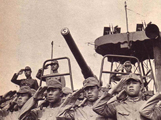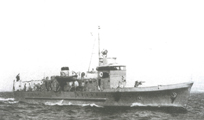- Navy:
- River Defence Fleet and Maritime Police of Manzhouguo, 1932-45
- Name:
- µ▒¤ķś▓Ķł░ķś¤ = Jiangfang Jiandui / µ▒¤õĖŖĶ╗Ź = Jiang Shangjun & µĄĘõĖŖĶŁ”Õ»¤ķÜŖ = Haishang Jingchadui
- Career:
In September 1931 the Japanese Army invaded the Chinese region of Manchuria and on 18 February, 1932 created the state of Manzhouguo (Manchukuo), a puppet state actually governed by Japanese advisors and military. The Chinese Songha (Sungari) River Fleet surrendered to the Japanese on 15 February and became the River Defence Fleet (Jiangfang Jiandui) of the new state. Their commander, Captain Yin Zuoqian, was appointed head of the new navy with the rank of Rear Admiral, but real control was held by the head of the Japanese naval mission, Captain Seiichi Ito. The fleet was made up of five Manchu river gunboats (Lisui, Liji, Jiangqing, Jiangping, Jiangtong) based at Harbin. The Japanese reinforced it with four armoured gunboats (Shuntian, Yangmin, Dingbian, Qinren), six river gunboats (Datong, Limin, Xichun, Yangchun, Xingya, Xingren), eighteen patrol boats, several supply vessels and three naval infantry battalions, with a total of more than 2000 men in 1940. Most of the officers and some of the ratings came from the Imperial Japanese Navy.
In February 1939, when Japanese Navy lost political influence over Manchuria, many of its naval instructors were forced to withdraw. The fleet was incorporated into the army and renamed the River Army (Jiang Shangjun). Its commander, the now Vice-Admiral Yin Zuoqian received the rank of lieutenant general. He was succeeded by Generals Li Wenlong (March 1941-September 1942), Xian Yuan (September 1942-March 1944) and Cao Bingsen (March 1944-August 1945).
The River Defence Fleet was used primarily for control of river navigation, support for the army against Chinese forces resisting Japanese occupation and defence of the river border with the USSR on the Songha, Heilongjiang (Amur) and Wusuli (Ussuri) rivers. Although resistance was reduced considerably after 1936, tension with the Soviet Union increased, leading to numerous border incidents, such as the dispute over Ganchazi or Bolshoi island (19-30 June 1937) in which a Soviet gunboat was sunk; Donganzhen (27 May 1939) with one Manchu patrol boat sunk and another captured and Xingkai or Janka lake (May 1942) where Soviet aircraft machine-gunned two Manchurian patrol boats.
In 1942 most of the remaining Japanese personnel in the flotilla rejoined the Japanese Navy, diminishing the forceŌĆÖs operational efficiency. On 9 August, 1945 Soviet troops invaded Manzhouguo. The crews of four gunboats and three patrol boats mutinied and surrendered to the Soviets or the Chinese resistance. The rest of the fleet was captured by Soviet troops when they took Harbin on 20 August.
Unrelated to the River Fleet, the Japanese Navy organized in April 1932 the Maritime Police (Haishang Jingchadui) under the Manzhouguo Ministry of Interior. Its mission was to patrol the coast of Bohai and Huanghai (Yellow Sea) and the Liaohe River, but from 1942 it also performed escort duties for coastal shipping. Initially the Maritime Police was made up of two patrol boats (Jinghai, Kuaima) and twelve armed junks. Later on it received one destroyer (Haiwei), two gunboats (Hailong, Haifeng), seven patrol boats (Rongan, Juntong, Jiuzhong, Haiguang, Hairong, Haihua, Hairui), one armed transport (Haiwang), eighteen patrol launches and up to a dozen airplanes. Heading the unit was the Japanese Navy Captain Toshimisu Miyabe, replaced in 1936 by Hiroshi Sakura of equal rank, and soon after by Wakaki Genji. The main base was Yingkou and at one point it had around 800 men, half of them Japanese sailors. The Haiwei was returned to the Japanese Navy in 1942, the Kuaima was accidentally lost in a storm (October 1944), the Haiwang was torpedoed and sunk by the American submarine Billfish (7 August 1945) and the remaining vessels were captured by the Soviets when they took Yingkou and Lushun (20 and 22 August 1945).





